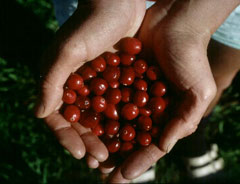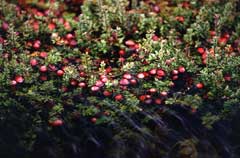 |
|
(c) 2010 Ken Fern & Plants For A Future |
 |
|
Translate this page:
Summary
Physical Characteristics

 Vaccinium macrocarpon is an evergreen Shrub growing to 0.2 m (0ft 8in) by 2 m (6ft) at a medium rate.
Vaccinium macrocarpon is an evergreen Shrub growing to 0.2 m (0ft 8in) by 2 m (6ft) at a medium rate.
See above for USDA hardiness. It is hardy to UK zone 2. It is in leaf all year, in flower from June to August, and the seeds ripen from August to October. The species is hermaphrodite (has both male and female organs) and is pollinated by Insects. The plant is self-fertile.
Suitable for: light (sandy) and medium (loamy) soils, prefers well-drained soil and can grow in nutritionally poor soil. Suitable pH: mildly acid soils and can grow in very acid soils.
It can grow in semi-shade (light woodland) or no shade. It prefers moist or wet soil.
UK Hardiness Map
US Hardiness Map
Synonyms
Oxycoccus macrocarpus. (Ait.)Pursh.
Plant Habitats
Woodland Garden Sunny Edge; Dappled Shade; Ground Cover; Bog Garden;
Edible Uses
Edible Parts: Fruit
Edible Uses:
Fruit - raw or cooked[2, 11, 17, 46, 101]. It can also be dried for winter use[62]. Rich in vitamin C[200], the fruit is too acid for most peoples tastes to be eaten raw, so it is mainly used in pies, preserves etc[183]. It is said that a teaspoon of salt added to the cooking fruit can take the place of half the sugar normally used[183]. The fruit is between 1 and 2cm in diameter[200].
References More on Edible Uses
Medicinal Uses
Plants For A Future can not take any responsibility for any adverse effects from the use of plants. Always seek advice from a professional before using a plant medicinally.
Antineoplastics Appetizer Hypoglycaemic Miscellany Vitamin C
An infusion of the branches has been used as a treatment for pleurisy[257].
References More on Medicinal Uses
The Bookshop: Edible Plant Books
Our Latest books on Perennial Plants For Food Forests and Permaculture Gardens in paperback or digital formats.

Edible Tropical Plants
Food Forest Plants for Hotter Conditions: 250+ Plants For Tropical Food Forests & Permaculture Gardens.
More

Edible Temperate Plants
Plants for Your Food Forest: 500 Plants for Temperate Food Forests & Permaculture Gardens.
More

More Books
PFAF have eight books available in paperback and digital formats. Browse the shop for more information.
Shop Now
Other Uses
Miscellany
Plants can be grown as a ground cover when planted about 1 metre apart each way[208]. Plants spread rapidly when they are thriving[208].
Special Uses
Food Forest Ground cover
References More on Other Uses
Cultivation details
Requires a moist or semi-boggy lime free soil, preferring one that is rich in peat or a light loamy soil with added leaf-mould[11, 200]. Prefers a very acid soil with a pH in the range of 4 to 4.5, plants soon become chlorotic when lime is present[200]. Plants grow best in a poor soil, richer soils result in extra foliage production at the expense of fruit[200]. Succeeds in full sun or light shade though it fruits better in a sunny position[200]. Requires shelter from strong winds[200]. A very dwarf shrub producing long slender creeping stems that root into the soil. Upright stems grow from the axillary buds in the second year and these upright stems flower and fruit the following year[200]. Widely cultivated for its edible fruit in N. America, there are many named varieties[11, 183, 200]. Cultivated plants are usually grown in artificial bogs that are often flooded in the winter[200]. Plants can self-fertilize but cross-fertilization by insects results in higher yields[200]. Cultivated plants take about 5 years to come into full bearing but will then crop well for 60 - 100 years[200]. Dislikes root disturbance, plants are best grown in pots until being planted out in their permanent positions[200]. Plants in this genus are notably resistant to honey fungus[200]. For polyculture design as well as the above-ground architecture (form - tree, shrub etc. and size shown above) information on the habit and root pattern is also useful and given here if available. An evergreen. The root pattern is flat with shallow roots forming a plate near the soil surface [1-2]. The root pattern is stoloniferous rooting from creeping stems above the ground [1-2].
References Carbon Farming Information and Carbon Sequestration Information
Temperature Converter
Type a value in the Celsius field to convert the value to Fahrenheit:
Fahrenheit:
The PFAF Bookshop
Plants For A Future have a number of books available in paperback and digital form. Book titles include Edible Plants, Edible Perennials, Edible Trees,Edible Shrubs, Woodland Gardening, and Temperate Food Forest Plants. Our new book is Food Forest Plants For Hotter Conditions (Tropical and Sub-Tropical).
Shop Now
Plant Propagation
Seed - sow late winter in a greenhouse in a lime-free potting mix and only just cover the seed[78]. Stored seed might require a period of up to 3 months cold stratification[113]. Another report says that it is best to sow the seed in a greenhouse as soon as it is ripe[200]. Once they are about 5cm tall, prick the seedlings out into individual pots and grow them on in a lightly shaded position in the greenhouse for at least their first winter. Plant them out into their permanent positions in late spring or early summer, after the last expected frosts. Cuttings in April of shoots 15cm long, in a sandy mix in a frame covered in plastic to keep them moist[200]. Cuttings of half-ripe wood, 5 - 8cm with a heel, August in a frame[78]. Slow and difficult. Layering in late summer or early autumn[78]. Another report says that spring is the best time to layer[200]. Takes 18 months[78]. Division of suckers in spring or early autumn[113].
Other Names
If available other names are mentioned here
Large cranberry, Da guo yue jie, Airelle a gros fruits, Kranbeere, Mirtillo palustre, Arando trepador, Craisons,
Native Range
NORTHERN AMERICA: Canada, Québec, Nova Scotia, Ontario, Prince Edward Island, New Brunswick, Newfoundland and Labrador (southeast. & south-central), St. Pierre and Miquelon, United States, Connecticut, Indiana (north), Maine, Massachusetts, Michigan, New Hampshire, New Jersey, New York, Ohio, Pennsylvania, Rhode Island, Vermont, West Virginia, Illinois (northeast), Minnesota, Wisconsin, Delaware, Maryland, North Carolina (northeast & west), Tennessee, Virginia, District of Columbia,
Weed Potential
Right plant wrong place. We are currently updating this section.
Please note that a plant may be invasive in one area but may not in your area so it's worth checking.
Conservation Status
IUCN Red List of Threatened Plants Status :

Growth: S = slow M = medium F = fast. Soil: L = light (sandy) M = medium H = heavy (clay). pH: A = acid N = neutral B = basic (alkaline). Shade: F = full shade S = semi-shade N = no shade. Moisture: D = dry M = Moist We = wet Wa = water.
Now available:
Food Forest Plants for Mediterranean Conditions
350+ Perennial Plants For Mediterranean and Drier Food Forests and Permaculture Gardens.
[Paperback and eBook]
This is the third in Plants For A Future's series of plant guides for food forests tailored to
specific climate zones. Following volumes on temperate and tropical ecosystems, this book focuses
on species suited to Mediterranean conditions—regions with hot, dry summers and cool, wet winters,
often facing the added challenge of climate change.
Read More
Expert comment
Author
Aiton.
Botanical References
1143200
Links / References
For a list of references used on this page please go here
Readers comment
| Add a comment |
|
If you have important information about this plant that may help other users please add a comment or link below. Only comments or links that are felt to be directly relevant to a plant will be included. If you think a comment/link or information contained on this page is inaccurate or misleading we would welcome your feedback at [email protected]. If you have questions about a plant please use the Forum on this website as we do not have the resources to answer questions ourselves.
* Please note: the comments by website users are not necessarily those held by PFAF and may give misleading or inaccurate information.
To leave a comment please Register or login here All comments need to be approved so will not appear immediately.
|
Subject : Vaccinium macrocarpon
|
|
|
|